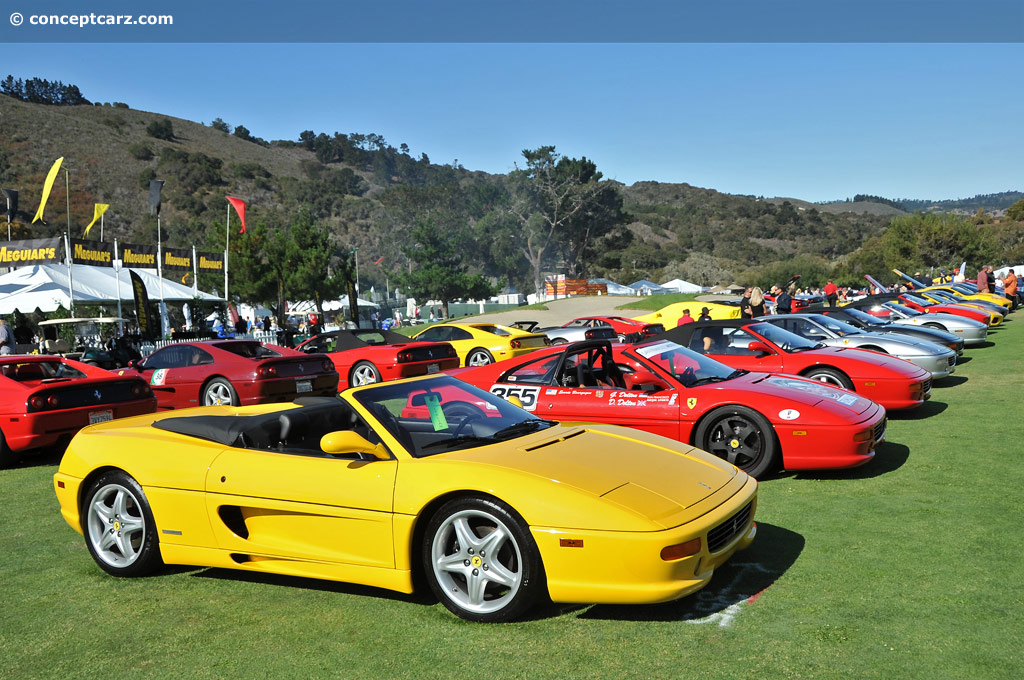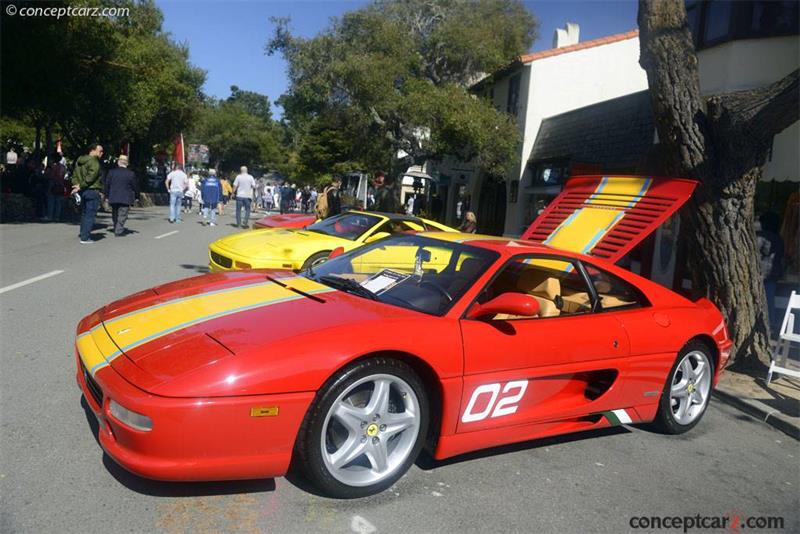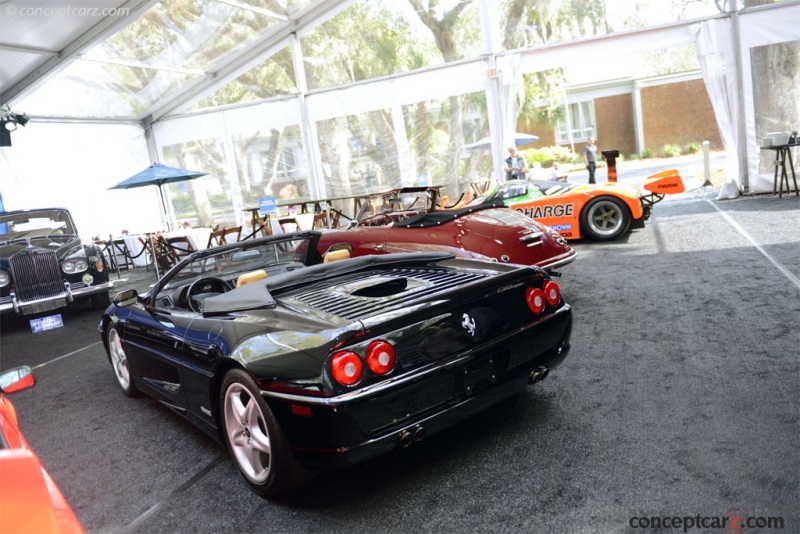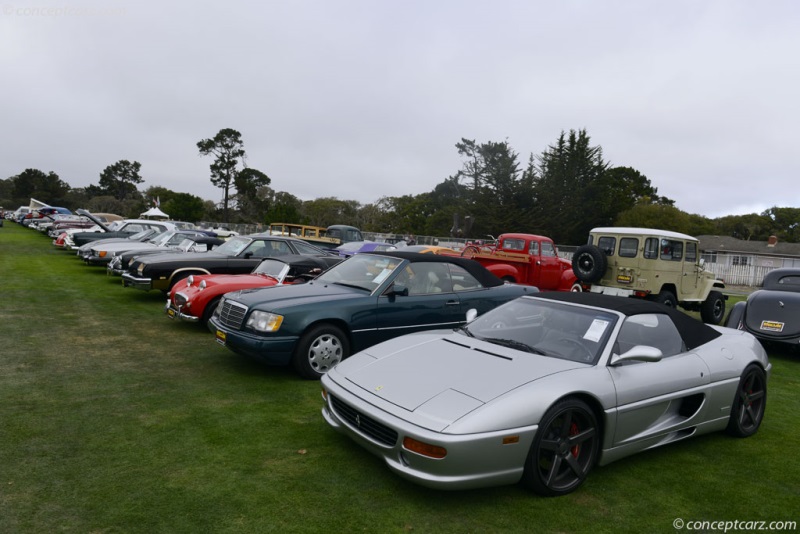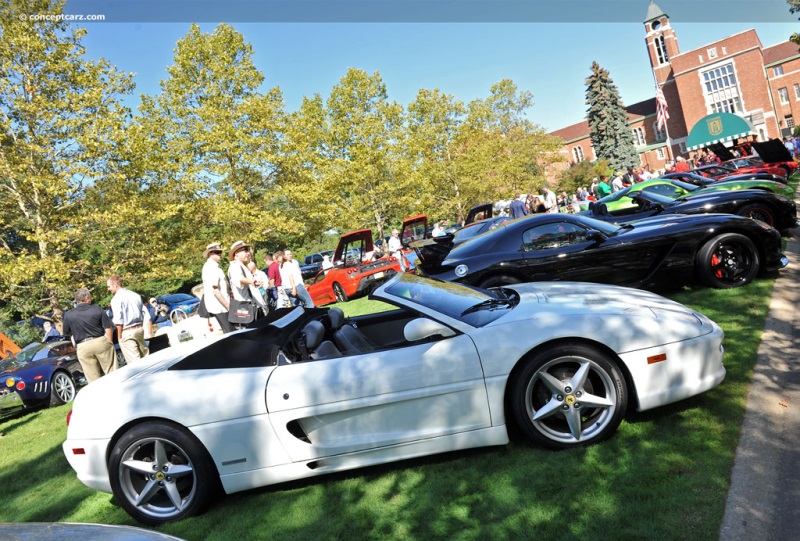1997 Ferrari F355 Navigation
The Ferrari F355 was a revolutionary vehicle for the Italian marque as it signaled the beginning of the end of the old guard 'Ferraristi' philosophy that the only 'real' Ferraris were ones with 12 cylinder engines. It straddled the cusp between analog and digital and was the last of the hand-built cars before the 360 and later descendants moved to mass production. 
GTS Spider
Chassis #: 107002Inheriting the proportions of its predecessor, the 348, the F355 was outwardly a much better-resolved proposition, both aerodynamically and aesthetically. Many hours of wind tunnel testing (over 1,300 hours) influenced the harmonious shape, which incorporated an F1-style flat bottom with channeled airflow generating enough downforce to offset any lift. Bodystyles initially included a fixed-head Berlinetta or Targa-topped GTS, and was later joined by a spider variant twelve months later. The chassis was a steel monocoque with a tubular steel rear sub-frame and a suspension system comprised of unequal-length wishbones, coil springs over gas-filled telescopic shock absorbers with electronic control servos and anti-roll bars. Two damper settings of 'Comfort' and 'Sport' allowed adaptability to various driving conditions and uses. The Pirelli tires measured 225/40ZR 18 at the front and 265/40 ZR 18 at the rear. Concealed beneath the smoother skin were numerous advancements, including variable damping, a 100cc engine enlargement, and power steering. The longitudinally mounted 3496cc V8 produced 380 horsepower at 8,250 rpm and the gearbox now had six speeds with a revised synchromesh making gear changes even smoother. The F355's name is derived from its 3.5-liter V8 engine and five valves per cylinder - as denoted by the Cinquevalvole' inscription on the rocker covers. (3.5-liter capacity and 5 valves per cylinder). This nomenclature did not follow Ferrari's traditional naming scheme of engine capacity (in liters) followed by the number of cylinders. 
GTS SpiderThe F355's stroke was 2mm larger than the 348's engine (77mm vs 75 mm), resulting in the displacement increase from 3,405cc in the 348 to 3,495cc in the F355. A new head design allowed for improved intake permeability, engine lubrication was via a dry-sump oiling system, and the compression ratio of 11:1 employed a Bosch Motronic 2.7 engine control unit in the 1995 model year, later changed to the M5.2 in 1996 through the end of production. The electronic fuel injection and ignition systems were controlled by a Motoronic system, with a single spark plug per cylinder. The connecting rods are forged in Ti6-Al-4V titanium alloy, the clutch is housed in magnesium alloy, and the Bilstein shock absorbers use electronic sensors to provide active damping. The stiffness of the suspension could be varied within milliseconds to suit the road surface, thanks to the new electronically adjustable shock absorbers. Issues with the transmission on earlier models were addressed with the addition of a coolant heat-exchanger which warmed the gearbox oil quickly, and a rod-driven actuation system for precision gear shifts. The power-assisted steering improved low-speed drivability compared to the outgoing 348 and could be replaced with an optional manual steering rack setup by special order. All of these changes allowed the F355 to lap Ferrari's 1.86 mile Fiorano test track two seconds faster than the 12-cylinder 512 TR. The interiors were upholstered with hides from Connolly leather, and are fitted asymmetrically in the car, resulting in the driver being slightly closer to the car's centerline than the passenger. Ferrari introduced the open-topped F355 Spider in 1955 representing the first production prancing horse to be equipped with an electronically powered, semi-automatic soft-top. The Pininfarina-penned lines had been honed by even more hours in the wind tunnel and to compensate for the lack of torsional rigidity caused by the lack of roof, the 355's structure was cleverly strengthened without making the Spider any heavier than the Berlinetta. Initially, the Spider was fitted with the 6-speed manual transmission prior to being offered with the innovative electro-hydraulic F1 transmission.
GTS SpiderThe Limited Edition Serie Fiorano was built for the 1999 model year with various enhancements aimed at improving its track performance. Upgrades included a competizione-sourced steering rack, carbon fiber inserts, suede-covered steering wheel, drilled and ventilated disc brakes and competition brake pads, and a competizione-derived Fiorano suspension pack (with a thicker anti-roll bar, stiffer springs, and a wider track).The United States received the lion's share of the Serie Fiorano, with 100 examples being sent across the pod, including 74 with the F1 paddle-shift transmission and 26 with the 6-speed manual. One example went to South Africa, and three remain in Europe. Production
Ferrari produced the F355 from May of 1994 for the 1995 model year through 1999, with 11,273 examples built. Of those, 4,871 were road-going Berlinetta body styles with 3,829 of those fitted with the six-speed manual transmission and 1,042 with F1 transmissions. Of the 3,717 examples of the F355 Spider built, 2,664 had the 6-speed manual transmission and 1,053 with the F1 transmission. 104 examples were the limited production run of 'Serie Fiorano' models. As many as 300 examples were F355 Challenge, however, it is more likely that 18 right-hand drive examples were imported by Ferrari UK, plus 10 for the rest of the right-hand-drive markets - thus a total of 28. Other sources state that 108 examples were built in total.Ferrari F355 Challenge
The F355 Challenge was introduced by Ferrar in 1995 as a race-ready model designed for use specifically in the Ferrari Challenge Series. The vehicle began life as a standard Ferrari F355 Berlinetta and was then modified with a $30,000 factory-to-dealer supplied kit. Initially, in 1995, the cars were supplied with factory-fitted cage mounts and without carpets, however, each year, the cars arrived with more and more factory-fitted race parts, culminating in 1998 with full-evolution cars which were supplied as virtually complete race cars.
GTS Spider
Chassis #: 108488The modifications made by the factory were more substantial than its predecessor, the 348 Challenge, and the engine, gearbox and shock-absorbers were sealed with special tags to prevent unauthorized alterations. The engine and physical dimensions were the same as the original road-going car and were backed by a 6-speed manual transmission. At the Ferrari factory, the F355 Challenge received a roll-cage, racing bucket seats, manual radiator fan control and upgraded fans, competition steering wheel, competition clutch, upgraded 14-inch Brembo brakes (carried over from the F40), solid suspension bushes, competition springs, and brake cooling ducts amongst a number of other detail changes from the base car.
by Daniel Vaughan | Feb 2022
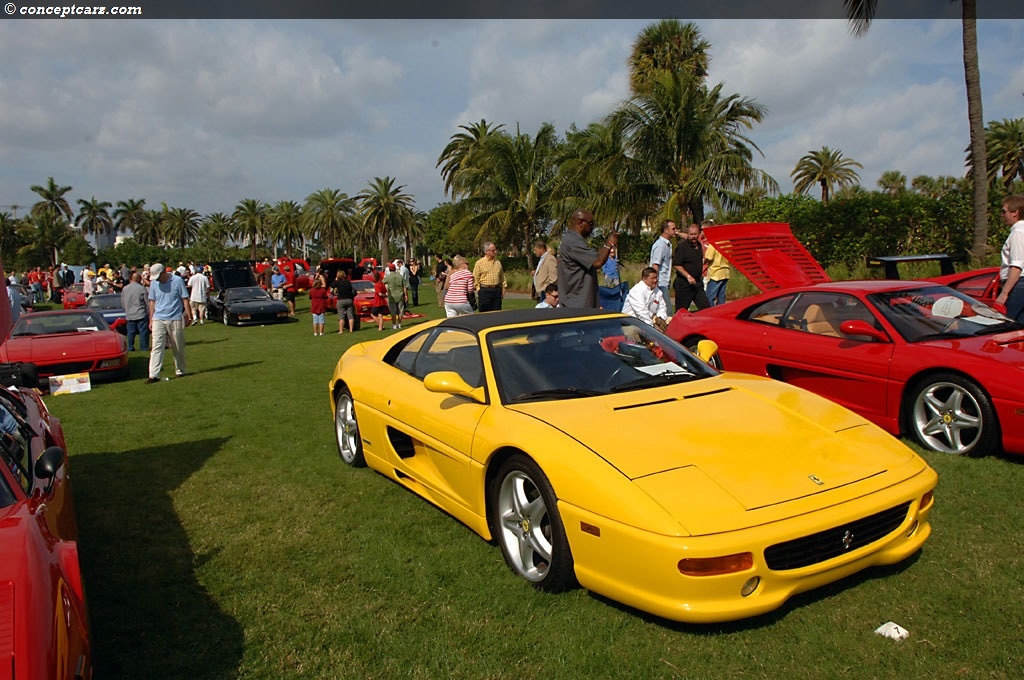
GTS Spider
Chassis #: 107002
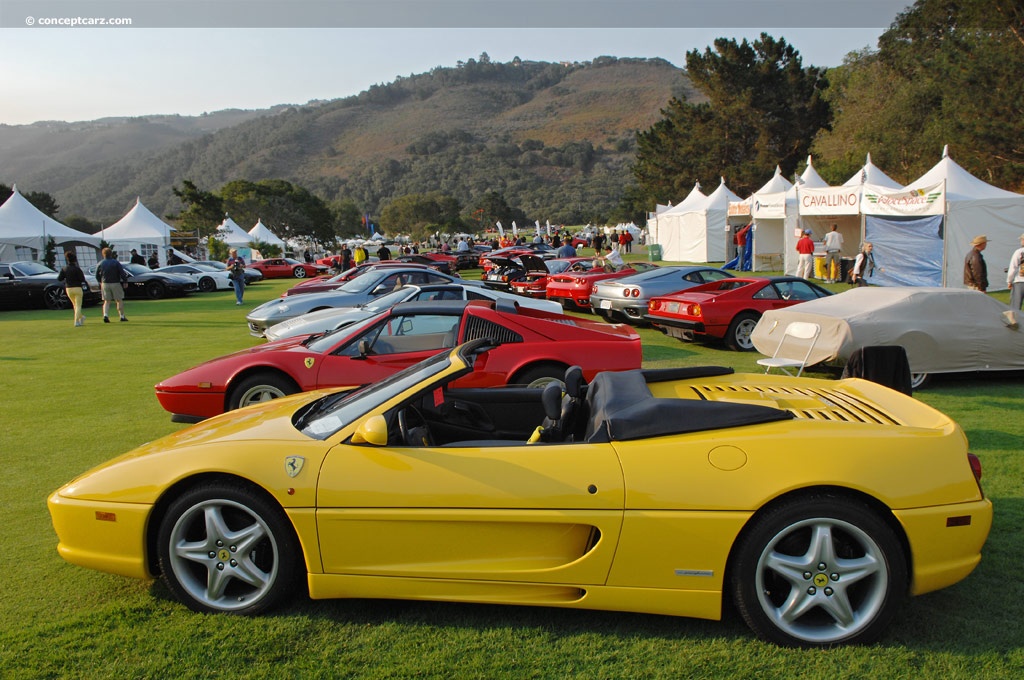
GTS Spider
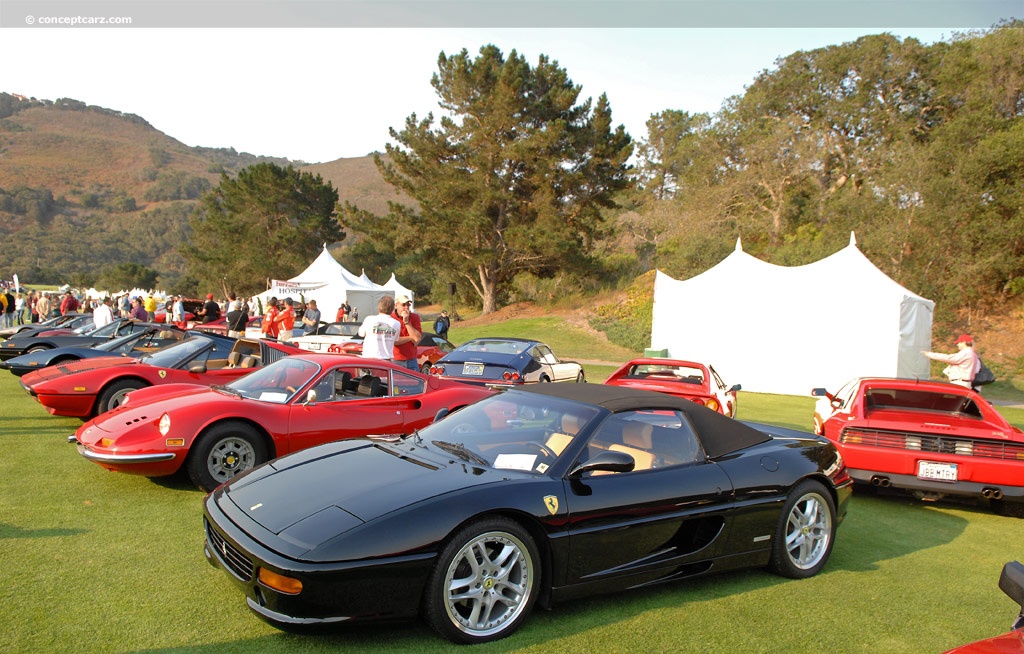
GTS Spider
Ferrari produced the F355 from May of 1994 for the 1995 model year through 1999, with 11,273 examples built. Of those, 4,871 were road-going Berlinetta body styles with 3,829 of those fitted with the six-speed manual transmission and 1,042 with F1 transmissions. Of the 3,717 examples of the F355 Spider built, 2,664 had the 6-speed manual transmission and 1,053 with the F1 transmission. 104 examples were the limited production run of 'Serie Fiorano' models. As many as 300 examples were F355 Challenge, however, it is more likely that 18 right-hand drive examples were imported by Ferrari UK, plus 10 for the rest of the right-hand-drive markets - thus a total of 28. Other sources state that 108 examples were built in total.Ferrari F355 Challenge
The F355 Challenge was introduced by Ferrar in 1995 as a race-ready model designed for use specifically in the Ferrari Challenge Series. The vehicle began life as a standard Ferrari F355 Berlinetta and was then modified with a $30,000 factory-to-dealer supplied kit. Initially, in 1995, the cars were supplied with factory-fitted cage mounts and without carpets, however, each year, the cars arrived with more and more factory-fitted race parts, culminating in 1998 with full-evolution cars which were supplied as virtually complete race cars.

GTS Spider
Chassis #: 108488
by Daniel Vaughan | Feb 2022
Related Reading : Ferrari F355 History
For the F355, Ferrari developed a new 3.5 liter 90° V8 engine developing 375bhp at 8250 rpm with a redline of 8500 rpm. Maximum torque was 268 lbs-ft at 6000 rpm. The specific output of this remarkable 5-valve unit was 109bhp per liter. The engines aluminum block had Nikasil-coated wet steel liners. Peculiarly light forged aluminum-alloy pistons drove the crankshaft through titanium alloy con....
Continue Reading >>
Continue Reading >>
- 1997 Ferrari F355 Menu
- Article
- Image gallery
- Valuation
- Specifications
- Profiles
- Recalls
Ferrari
Similar Automakers
Similarly Sized Vehicles
from 1997
1997 Ferrari F355 Vehicle Profiles
Recent Vehicle Additions
Performance and Specification Comparison
Price Comparison
$224,805
$258,000
$487,005
F355 Specification Comparison by Year
Year
Production
Wheelbase
Engine
Prices
Related Automotive News

Emira: the most powerful four-cylinder Lotus sports car ever
Second powertrain in the Emira range extends appeal of award-winning Lotus State-of-the-art, 360bhp (365PS) mid-mounted makes Emira most powerful four-cylinder Lotus sports car of all time Eight-speed dual-clutch tran...

Subaru Announces Pricing On Limited Edition 2018 WRX STi Type RA® And BRZ TS®
Limited Edition of 500 of each model
Suspension tuned by STI®
Exclusive Cherry Blossom Red accents
Carbon fiber rear spoiler
Three color options
WRX STI Type RA offers increased performance through weight reduction and engine upgrades
BRZ tS r...

THE McLAREN F1
FOR THE DRIVER VITALLY – AS IN ONE OF McLARENS WORLD CHAMPION RACING CARS – DRIVER AND VEHICLE BECOME ENTIRELY AS ONE
The primary design consideration for the McLaren F1 has been to make it without reserve a drivers car, an extremely high-performance...

NEW CHEVROLET CAMARO TESTED AND TUNED ON EIGHT TRACKS, AND THE AUTOBAHN
All-new Camaro makes European debut at Goodwood Festival of Speed
GOODWOOD, UK – To celebrate its return to the Goodwood Festival of Speed, Chevrolet has shipped a surprise across the Atlantic for its European debut – the 2016 Chevrolet...

DODGE UNLEASHES MOST POWERFUL MUSCLE CAR EVER
All-new 2015 Dodge Challenger SRT with 707 horsepower HEMI® Hellcat engine delivers unrivaled performance, race-inspired interior and new technologies geared toward the driving enthusiast
New 2015 Dodge Challenger SRT Hellcat features the all-new...
